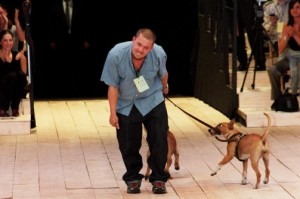Alexander McQueen’s will was unveiled this week, and the late British designer, who died in 2010, included provisions for his beloved English bull terriers–50,000 pounds in all (82,126 US dollars). In addition, he left twice that amount to two charities that help animals: the Battersea Dogs and Cats Home and the Blue Cross Animal Welfare Charity.
While McQueen left the bulk of his estate to his own charity, newspaper headlines focused on the amount left to the dogs. However, bequeaths to animal charities are not new. As Battersea told the Guardian newspaper, 77% of its funds come from legacies. American Philanthropist Brooke Astor left $250,000 to the Animal Medical Center in New York City — specifically for the veterinary care of the pets of poor and old people–when she died in 2007 at the age of 105.
The most famous dog named in a will died earlier this year. Hotelier Leona Helmsley’s dog, Trouble, was named in her will with $12 million left for her care. A judge later reduced that amount to $2 million, and Trouble lived out her days at a Helmsley property in Sarasota, Florida.
In an interesting note for bully breed lovers like McQueen, Battersea noted that 43% of the dogs in its care are staffordshire bull terriers.


